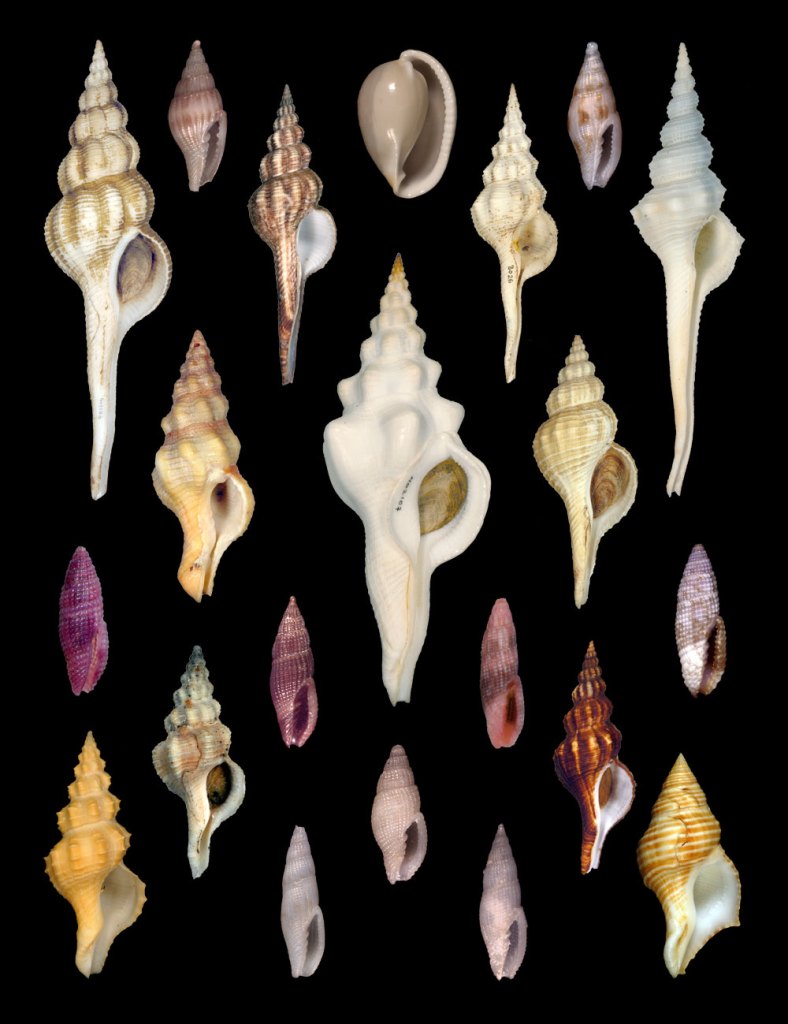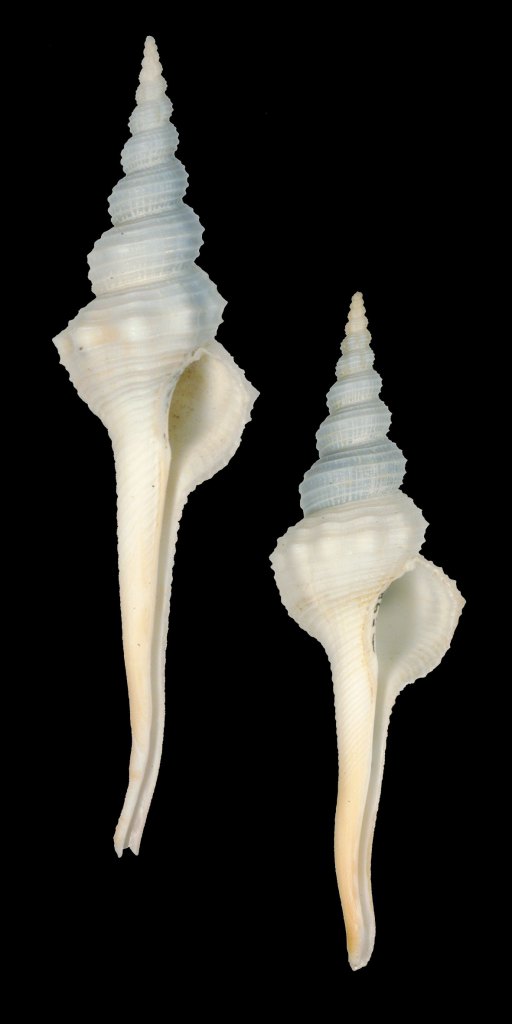Beyond the Academy’s dioramas and dinosaurs lie its vast scientific collections. Rows of gleaming metal cabinets hold millions of shells, birds, insects, fossils, fish, plants and everything in between. In darkened rooms, the bodies of squids, lizards, eels and crabs are suspended in stable fluid for all time on shelf after shelf of tanks and jars. These collections represent one of the world’s great archives of nature and are a vital key to understanding changes in our environment.

Upper middle: Hemipolygona lamyi Snyder, 2007; Fusinus mauiensis Callomon & Snyder, 2006; Fusinus amadeus Callomon & Snyder, 2008
Lower middle: Thala lillicoi Rosenberg & Salisbury, 2007; Mitromica calliaqua Rosenberg & Salisbury, 2003; Thala hilli Rosenberg & Salisbury, 2007; Thala gorii Rosenberg & Salisbury, 2003
Bottom row: Hemipolygona honkeri Snyder, 2006; Fusolatirus higoi Snyder & Callomon, 2005; Mitromica oryza Rosenberg & Salisbury, 2003; Mitromica dicksoni Rosenberg & Salisbury, 2003; Mitromica williamsae Rosenberg & Salisbury, 2003; Fusinus emmae Callomon & Snyder, 2010; Dentifusus deynzeri Vermeij & Rosenberg, 2003
Image by Paul Callomon/ANS
The collections are arranged according to principles of taxonomy — the art of distinguishing and naming separate species and grouping them based on their relatedness — and are presided over and inhabited by people known as taxonomists. Everything in the collections is carefully labeled, but not every label has a full scientific name. Some simply give the broad group to which the specimens belong, followed by the term “sp.” or “undet.,” meaning that the species name has not been established.
This might just mean that no-one has yet gotten around to identifying it, but in many cases a full examination will reveal that the animal or plant is a new species to science. The discovery of new species in museum collections is a surprisingly common event. Every year, roughly 20,000 new organisms are named in the scientific literature (over half of them insects). This enormous number of species is termed the earth’s biodiversity and reflects hundreds of millions of years of evolution. Few new discoveries are recognized as such in the field during an expedition, however. They must first be cleaned, preserved and sorted before the fine work of identifying species can begin.

A Knowing Eye
Discovering a new species requires the happy union of two things — the specimens themselves and an experienced pair of eyes. Those eyes are scarce, however, and they only occasionally enter the same space as unnamed specimens. Once expedition material has been brought back from the field and placed in a museum’s collection, therefore, it may yet be many years — hundreds, in some cases — before the two meet.
We can nevertheless be sure from their sheer size alone that the Academy’s collections contain many new species just waiting for someone with the right expertise to discover them. That expertise has two parts. The first is a knowing eye, what some call the “Grand Central Station effect.” From the balcony in Grand Central Station, you could easily pick out your friend or relative among the vast sea of people below. Likewise, when a dredge full of mixed sea life, sand and rubble is spread onto a boat’s deck, a mollusk person can immediately spot the shells in the jumble, a worm person the worms and so on. It is more than just spotting things; it’s recognition. The second element is a deep knowledge of the literature — what species have already been named, where they are from and what they look like.
Taxonomists are famously born, not bred. The urge to classify things is universal to humans and takes many forms; accountants, doctors and trash pickers, for example, all classify the things they work with. Natural scientists, however, usually also engage personally with a particular kind of thing. If you ask specialists in birds, worms, shells or palm trees, most will say that their attachment to their chosen organism is emotional and hard to justify in logical terms and that it started at a young age. The happiest taxonomists work in areas with high rates of unresolved classification and undescribed species, such as mollusks and insects, where they can make frequent discoveries and help reveal more of nature’s gigantic and ever-changing mechanism.
Vital though their work is, professional taxonomists are so few in number that they are themselves often described as an endangered species! More than half the new species descriptions in scientific literature each year are written by private enthusiasts. This has been the case since Victorian times and is unlikely to change given how much work remains to be done. The rate of new discoveries in the mollusks, for example, has not slowed since 1850, and probably more than half the living species remain to be named.
“Before the word ‘scientist’ was coined by William Whewell in 1833, everyone in the field was an ‘amateur’ — someone who does something for the love of it.”
Paul Callomon
In 1963, Academy mollusk curator R. Tucker Abbott flew to Thailand to join the International Indian Ocean Expedition. With some time to spare before the ship sailed, he visited one of the huge tin dredging barges anchored off Phuket in the company of a local doctor. From the sand being dredged up for its tin content they collected hundreds of Spindle Shells, a sea snail. Abbott sent them back to the Academy and on his return labeled them as a known and common species. As he had found so many, he divided them up and sent some to the Smithsonian Institution, the Delaware Museum of Natural History and Harvard University in exchange for other shells.
Abbott was a wellknown taxonomist and his identification was adopted without question by those other museums. It was not until 2008 that Academy Research Associate Martin Avery Snyder, PhD, and I, both specialists in Spindle Shells, went through the Academy’s collection and recognized Abbott’s shells as representing a separate and as yet undescribed species. That no one at any of these museums had spotted this in 45 years is no reflection on their staff, however; there are perhaps six Spindle Shell specialists in the world, and two of them are at the Academy.

There is a strong difference between fields of science such as medicine, physics and chemistry that create profitable technologies and involve strict qualifications and career structures, and slower, less pressurized fields that involve discovery and description, such as zoology and botany, where many workers earn a living elsewhere. Nevertheless, correct identification and the naming of new things are the foundations of all natural science, from geochemistry to genetics and pharmacology.

The study of ecosystem-wide effects like pollution and climate change relies on knowing which organisms are where and when, and as species come and go, it is essential that they be reliably identified. This makes it even more remarkable just how few opportunities there are for young people to get experience as taxonomists and, as a result, how scarce experts are, even in fields that are vital to human health and agriculture such as insects and parasites. Students in Drexel’s department of Biodiversity, Earth & Environmental Science (BEES) have an opportunity to study taxonomy with world leaders in various fields and get hands-on experience with identification and classification working in the Academy’s vast collections. In the Malacology Department, Gizelle Batomalaque recently completed her PhD in BEES, studying the land snails of her native Philippines.
Natural history museums play a vital role in taxonomy, both as a forum where professionals and amateurs work together to produce knowledge and as a showcase of nature where children encounter their first bugs and shells, perhaps sparking that lifelong involvement with one particular kind. A recent survey revealed that the length of time between a new species being collected in the field and its description being published is, on average, 21 years, so it’s vital that they all be sorted and kept ready for those experienced eyes to find.
By Paul Callomon, Collection Manager, Malacology and General Invertebrates
This article originally appeared in the Fall/Winter 2019 issue of Academy Frontiers, the Academy’s member magazine.
We need your support now more than ever. If you believe that science matters, please consider a donation to support the Academy’s efforts to ensure a healthy, sustainable and equitable planet.


